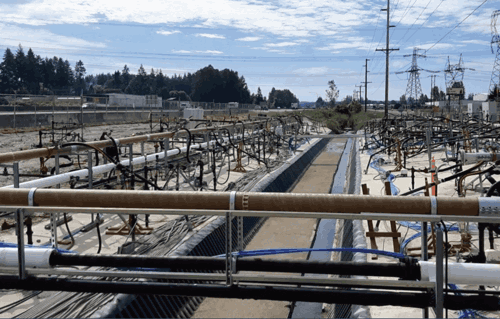Electrical Resistance Heating, or ERH, is a proven, reliable, and safe heating technology for thermally remediating contaminated sites. It’s been used all over the world for more than 25 years, and we’ve used it to successfully remediate 80+ contaminated sites. If you have been reading our blogs, you may have already read “What is Electrical Resistance Heating (ERH) and how does it Work?”.
Want to learn more? Watch our webinar, What is ERH and how is it Applied?
In this blog post, we will summarize when you should consider ERH for your site and walk you through a short case study of a project where ERH and Steam Enhanced Extraction (SEE) were used together to remediate a CVOCs/PCE DNAPL site. The project demonstrates the importance of carefully considering and selecting appropriate thermal technologies and designs to ensure successful thermal remedies.
When to Consider ERH
ERH works by passing current through the soil between an array of electrodes in a triangular grid pattern. This causes the soil and water to heat up and the heat causes the contaminants in the soil to vaporize. Those vapors are extracted by vapor extraction wells (VEWs) or multi-phase extraction wells (MPEs). The vapor is directed into an above-ground vapor treatment system, treated and cleaned, then discharged back into the atmosphere.
Three-phase alternating current (AC) is used to power the ERH electrodes. The electrodes in each triangular array are on different phases. The voltage difference between the phases or electrodes at any point in time is what drives current flow through the soil. The amount of current conducted by the electrode and passed through the soil is a function of the electrical conductivity of the soil. The higher the electrical conductivity, the higher the current flow for a particular voltage.
The electrical resistance of the soil (which is the inverse of the electrical conductivity of the soil), will convert some of the current flow to heat. In this way, 3-phase ERH can be used to heat the soil in between the electrodes to the desired temperature, which is typically 100°C.
Using ERH to heat a source zone to 100°C can mobilize large amounts of contaminant mass at a significantly faster rate than traditional pump and treat methods or cold soil vapor extraction. A typical ERH project only lasts six to eight months compared to pump and treat or soil vapor extraction methods which can take decades to achieve remediation goals, if ever.
Hamilton-Labree Roads Superfund Site, Chehalis, WA – Combined ERH and SEE Case Study
This project provides a good example of how heating technologies, in this case, ERH and SEE, can be effectively combined to address complex conditions. It shows that ERH, TCH, or SEE alone, are not one-size-fits-all technologies.
The release of PCE into a stream located between a major interstate and a service road created a DNAPL source area beneath the stream and downgradient plume. The deployment of both ERH and SEE was required to treat the heterogeneous subsurface lithology consisting of the following units in descending order, silt, upper outwash, till, and lower outwash. The silt and till units were too tight for SEE and groundwater flow in the outwash units was too high for ERH alone. The water table ranged from a few feet above the ground surface in the immediate vicinity of the stream (artesian conditions) to ~ 5 ft bgs at the outskirts of the treatment area away from the stream.

The stream running through the source area had to be isolated and insulated to protect it during heating from temperature impacts and COC migration. To do this it was relocated to an engineered channel and horizontal vapor extraction wells were used beneath and along the edges of the channel to control groundwater levels and ensure effective vapor capture beneath the stream and surrounding extents of the treatment zone.
The ERH/SEE design included multiple steam injection and ERH intervals combined with co-located SVE wells, MPE wells, and HVEWS and an insulated vapor cover integrated into the stream re-location channel. Once Phase 1 was complete, the stream was restored to preexisting conditions. Due to the confines and topography of the source area, the treatment system and steam boiler had to be located across the service road, and trenches were installed beneath the road to run the vapor and steam manifolds.
The heating design included a total of 83 separate electrodes combined with 49 separate SIWs in single and double, shallow, and deep configurations to target the various treatment intervals and zones. The total treatment volume heated and treated was 12,000 cy.
Soil resistivity data provided at the start of the design indicated starting soil resistivities in the range of 15 to 30 Ω●m for the silt and till, respectively, and 200 to 400 Ω●m for the outwash units.
Measurements of actual soil resistivity using the installed electrodes indicated average starting values for the silt and till of 160 and 170 Ω●m. Fortunately, sufficient flexibility and capacity were built into the design of the ERH system to allow for field modifications, specifically higher electrode voltages, to successfully heat the site in the planned duration.
An important lesson for successful ISTR projects is to always build in contingency and excess capacity. Actual site conditions encountered during ISTR can be different than indicated in the CSM and flexibility is key to keeping a project on schedule and within budget and meeting performance goals.
After 150 days of heating, all 101 soil confirmation samples collected at various depths across the site met the thermal remediation goals (<10 mg/kg PCE). The total contaminant mass removed from the site was 7,795 lbs, which was more than triple the estimated starting mass.
To summarize, ERH was selected to heat the silt unit due to the relatively thin interval (~6 ft) and concerns that TCH might potentially dry out the silt around the heaters, resulting in the discharge of groundwater to the surface and stream under the artesian conditions. SEE was selected for the outwash units as the best technology to offset high groundwater flux in these units and ensure effective heating. The sweet-spot technology for each of the units was selected based on careful consideration of the groundwater flux and heating characteristics of the units and overall performance and safety concerns. Neither ERH nor SEE alone (or TCH alone), would have been successful at the site.
If you would like to learn more about ERH and discuss if it’s the right thermal heating technology for your site, watch our webinar, What is ERH and how is it Applied?
01.24.23
John LaChance
John LaChance is the Vice President of Development at TerraTherm. In his 30+ year career in the remediation industry, he has worked on a range of project sites, including chemical manufacturing plants, gas stations, oil refineries, railroads, former MGP sites,...


